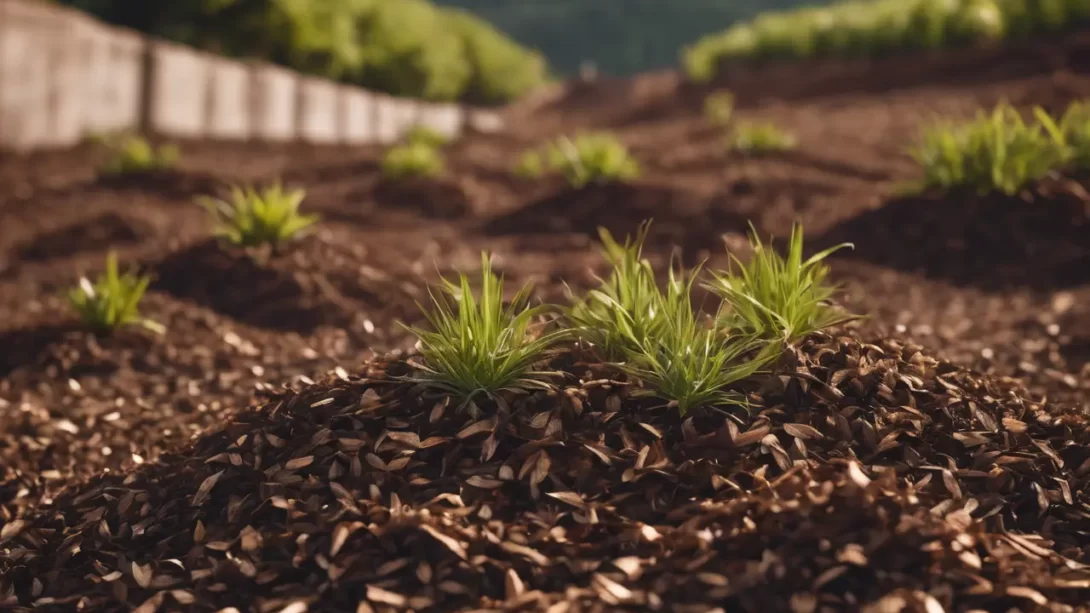Maintaining mulch on sloped garden areas presents a unique set of challenges. Mulch is crucial for protecting soil from erosion, retaining moisture, and suppressing weeds. However, keeping it in place on a slope requires careful planning and execution. This article will explore effective strategies to ensure your mulch stays put, preserving the health and beauty of your sloped garden areas.
The Challenges of Sloped Surfaces
On sloped surfaces, gravity and erosion are the primary culprits in mulch displacement. Rain and wind exacerbate the issue, often causing mulch to wash or blow away. This can lead to uneven coverage, exposing soil to the elements and reducing the mulch’s effectiveness. Recognizing these challenges is the first step in implementing solutions to keep mulch securely in place on a slope.
Choosing the Right Type of Mulch for Slopes
Selecting an appropriate mulch type is crucial for sloped areas. Heavier, chunkier mulches, such as bark chips or rubber mulch, are less likely to wash away compared to lighter options like straw or grass clippings. Organic mulches, while beneficial for soil health, may need more frequent replenishment on slopes. Inorganic mulches, like stones or rubber, can be more stable but don’t improve soil quality. The steepness of the slope and local climate conditions are important factors to consider when choosing your mulch.
Preparing the Slope for Mulching
Proper preparation of the slope can significantly improve mulch stability. Start by clearing the area of weeds and debris. Leveling out steep areas as much as possible can reduce the speed of water runoff, which helps in keeping the mulch in place. For slopes with loose or sandy soil, consider incorporating soil amendments to improve the soil structure and enhance the mulch’s ability to stay put. This groundwork sets the stage for a more successful mulching process.
Techniques for Applying Mulch on Slopes
Applying mulch on slopes requires specific techniques to ensure it stays in place. Begin by spreading a thin layer of mulch, about 2 to 3 inches thick, across the slope. Avoid piling it too thickly, as heavy layers can slide down, especially after rain. Layering the mulch in sections, moving upward or downward across the slope, helps in achieving even coverage. A crisscross pattern of application can also be effective, as it creates a natural barrier against downward movement of the mulch.
Using Physical Barriers and Edging
Incorporating physical barriers is a highly effective way to prevent mulch from sliding off sloped areas. Burlap or jute netting can be laid down before mulching to anchor the material. These fabrics allow water and air to penetrate while keeping the mulch in place. Edging materials like stones, bricks, or wood can be placed at the bottom of the slope to catch any mulch that does shift. These barriers not only serve a functional purpose but can also enhance the aesthetic appeal of your garden, adding structure and definition to the landscape.
Incorporating Plants to Help Retain Mulch
Planting certain types of vegetation can help in stabilizing mulch on slopes. Ground cover plants, such as creeping juniper or ivy, spread across the surface, holding the mulch and soil together with their roots. Deep-rooted species, like ornamental grasses, can also anchor the soil and mulch, reducing erosion and displacement. Choosing plants that are suitable for your climate and soil type will add to the stability and beauty of your sloped garden. This method not only aids in mulch retention but also contributes to the biodiversity and visual interest of the landscape.
Maintenance and Upkeep
Regular maintenance is key to keeping mulch in place on slopes. Periodically check the mulched areas, especially after heavy rain or strong winds, and reposition any displaced mulch. Over time, organic mulches will decompose, necessitating replenishment to maintain the desired depth. This is also an opportunity to inspect the underlying soil and make any necessary adjustments to the slope or barriers.
In different seasons, the maintenance needs may vary. For instance, during the rainy season, you might need to check and adjust the mulch more frequently due to the increased likelihood of washout. Conversely, in drier seasons, the focus may shift to ensuring the mulch is sufficient to retain moisture in the soil.
Seasonal Considerations
Seasonal changes can significantly impact the effectiveness and stability of mulch on a slope. In preparation for winter, consider adding a bit more mulch to protect the soil from freezing temperatures. In spring, as you prepare for planting and new growth, it’s a good time to refresh the mulch and reinforce any barriers or edging.
Conclusion
Successfully maintaining mulch on a slope requires a combination of the right materials, proper application techniques, and ongoing maintenance. Choosing suitable mulch, preparing the slope adequately, and using physical barriers can greatly enhance the stability of mulch on inclined surfaces. Incorporating plants with deep or spreading root systems further aids in holding the mulch in place. Regular checks and seasonal adjustments ensure the longevity and effectiveness of your efforts. With patience and attentiveness, your sloped garden can thrive, protected and beautified by well-maintained mulch.



